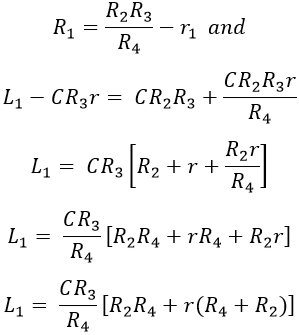The Anderson's bridge is an alternating current bridge, which is used to find the self-inductance of the circuit. Actually, this bridge is the modified form of Maxwell's inductance capacitance bridge for the measurement of self-inductance in terms of the standard capacitor of low Q coils (Q < 1). The bridge uses a fixed capacitor instead of a variable capacitor as seen in Maxwell's bridge and hence gives more accurate results.
Construction of Anderson’s Bridge :
The bridge consists of four arms AB, AD, BC, and CD. The arm AB of the bridge consists of unknown inductance to be measured in series with a non-inductive resistance R1 and r1 be the resistance of the inductor. The below shows the circuit diagram of Anderson's bridge under balance condition.
The arms AD, BC, and CD consist of standard non-inductive resistances R2, R3, and R4 of known value. It consists of extra junction E to which a variable resistor r is connected between E and D, a fixed capacitor between E and C, and a null indicator or detector between E and B.
Operation and Theory of Anderson’s Bridge :
Let,- C = Standard capacitor of fixed known value
- R2, R3, R4 = Standard non-inductive resistances of known values
- L1 = Self-inductance to be measured
- r1 = Resistance of the unknown inductor.
Under balanced condition, we have,
From equation 3, we have,
From equation 4, we have,
From equation 5, we have,
From equations 6 and 7, we have,
Equating real and imaginary parts on both sides, we get,
Therefore, the unknown value of self-inductance is,
The unknown value of resistance of the self inductor is,
Phasor Diagram of Anderson’s Bridge :
Taking current I1 as the reference phasor. The current I1 is passing through arm AB i.e., through non-inductive resistance R1 and inductor L1. Thus the total drop V1 in arm AB is I1 (R1 + r1) (which is in phase with I1) and I1 ωL1.
When the bridge is balanced the same current will also pass through R3 (in arm BC) i.e., I1 = I3. Thus the drop I3 R3 (i.e., V3) lies along the phasor I1. Also, we know that the potential between junctions BC will be equal to the potential between junctions EC. Hence V3 = Ic/ωC and the drop Ic r in the resistor r will lie along with Ic.
When the potential across the detector is zero (balanced condition) V4 will be equal to VEC. Thus V4 is nothing but the sum of drop, in resistor r, and VEC or V3. Adding the drop Ic r to the V3 we get V4 (i.e., drop I4 R4 in arm CD), also the current I4 lies along with V4.
Also, when the bridge is at balance condition, the current I2 is the sum of the currents Ic and I4, also the drop V2 (i.e., I2 R2) in arm AD due to I2 lies along with it. Therefore, the resultant of the phasors V1 and V3 or V2 and V4 gives supply voltage V.










